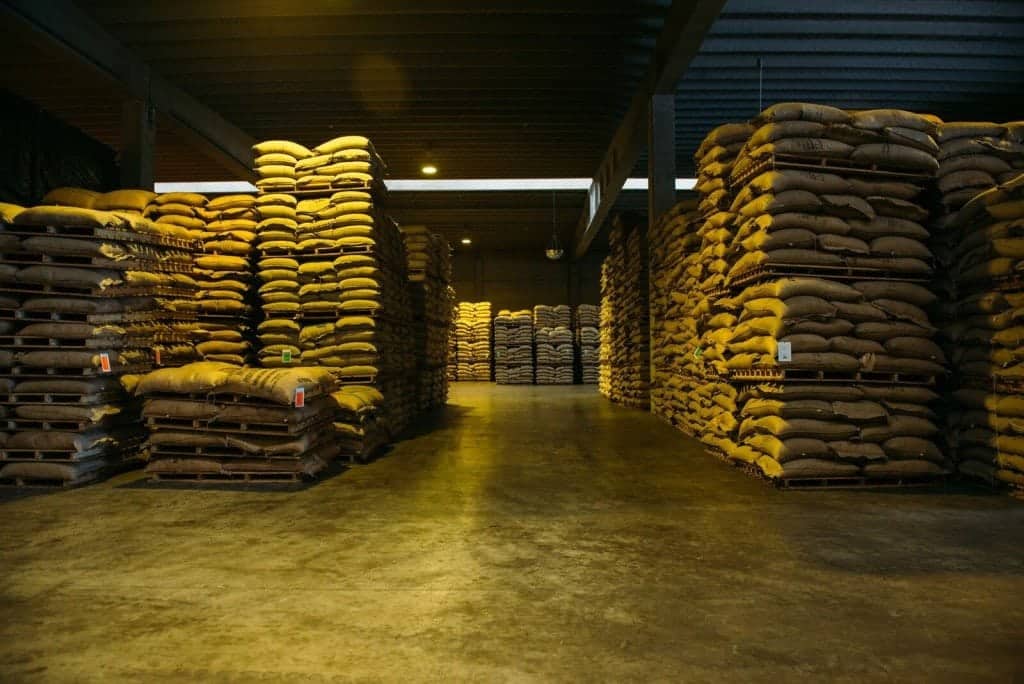The chance to visit the Port of Antwerp does not come easy. The Barista Guild of Europe made this possible for a full bus of CoLab:Antwerp attendees, allowing them to explore yet another part of the coffee logistics. We were keen to learn more about coffee shipments arrivals to Europe too, hopped on the bus and spent three hours touring the coffee port!

The tour of the historic port of Antwerp and the largest green coffee warehouse brought us to the water bank area of Antwerp. The port is spread over several quarters, covering over 1 million square metre storage facilities, with the coffee section housed in Molenbergnatie warehouses. “The warehouses are located close to the quayside. Furthermore all the sites have direct rail access, with up to 15 rail cars per week leaving for Switzerland alone. And of course there is also barge and truck transport,” describes the logistic advantages Matthias De Smedt of Molenbergnatie. Their warehouses have the capacity of 6,700 metric tons in the coffee bulk terminal, as well as 25,000 square metres of general cargo storage. The warehouse stores beans in 60 – 70 kg sacks, or alternatively in massive plastic containers, all neatly stocked up and piled up in rows.
We have learnt about the daily workload which comprises of examining newly delivered containers of coffee and checking they are not damaged, before discharging them. Big containers are checked for any misloaded articles in the delivery, such as wood and stones, which may accidentally access the load of beans. In case of a container of 60 – 70 kg bags each is examined for holes by a controller who pushes the bags forward on a belt transport. This takes the bag of coffee to a sampling station. A little sample is taken from as many bags as required by the buyer of the coffee, to examine the quality of the product, as well as its consistency throughout the delivery.

Antwerp is not the biggest nor the busiest city in Belgium, yet it has certain attributes, as explained by our guide, that make it the perfect location for a green coffee storage. The stable temperature and consistent moisture in the air are the most suitable for a long term storage of green beans. In winter, the temperature indoors is higher than outdoors, while in summer, the warehouse works as a cooling system.

To our surprise we were caught in rain and hail, as well as in sunshine during our time at the port, and we were equally blown away by some discoveries during our visit. Apparently, coffee, the second most dealt commodity after oil also serves as an insurance to some bigger companies. Those might stock up on a certain type of bean, solely for the purpose of having a leverage for when dealing with customers, bargaining a better deal with them. This and other reasons might lead to coffees being stored for years within the port. And they would still find a customer one day. This obviously is not the case of specialty and / or micro roasteries, yet it happens. There are 45,000 tons of green coffee in stock at any given time. The port is not only an important storage, but also a transportation point of beans coming from producing countries. When we thought of the beans coming through the port we imagined the micro lots and single containers for small roasteries that secured their coffee with farmers or cooperatives, yet the thought of a gigant customer, such as Nestle, would remain a bit distant to our ideas. Those are the kinds of customers that the port deals with primarily. The amount of coffee and the logistics that evolves around it are immense. Yet, every step is examined by individual workers and checked also manually.

It was not only the incredible amount of diverse coffees we saw, we also witnessed containers of separate rubbish that was processed at the control station. Seeing the dark side of coffee quality first hand, the hard work that is done at the port and the amount of coffee coming to Europe made us appreciate this trade even more.
Photo: Jordan Sanchez, photographer for the BGE the last two Barista Camps is soon to be the co-owner of Cedar Coffee Supply in Alpine, Texas.

